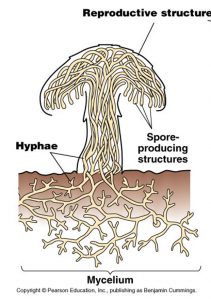A cruel side of independence is mold; there’s no sugar-coating it, we barely remembered it existed and now it’s in places we didn’t even know needed cleaning. But fungi can also clean what we leave lying around, not bathrooms or kitchens but the places where they come from. This is an underrated story about fungi and how they can restore ecosystems in former mines, cleaning the mess of our lifestyle.
Mineral exploitation leaves many problems in site. Soil alkalinity and deficiencies in minerals of importance for life make these areas an “inhospitable environment with huge loss of soil and water, vegetation recession, rock bareness, and productivity loss” as reads the research article by Yawen Wu and others about the fungal strain Gongronella sp (of the Cunninghamellaceae family of fungi) and its role in restoring life after rock mining.
But how can fungi solve such a complex problem? The team researched ways in which the fungi could aid a process known as external-soil spray seeding. The technique consists in spraying plant nutrients and seeds to restore vegetation. However, it tends to fail because the soil layers being too thin; this is where the Gongronella comes in.
The fungi can, in theory, do two things the spray can’t: degrade rocks to make the soil lining thicker and mold to the rocks to degrade them and release organic material from as deep as 12mm from the surface. This all because of their mycelia structure in which the fungus extends in ramifications towards their food source and can secrete chemicals from the tips or hyphae. These hyphae can also grow into the rock cracks and deepen decomposition.

Credit: Benjamin Cummings
To bring these characteristics into use, the team used the Gongronella sp fungi they isolated from a rock mine and cultured them in the presence of rock samples. They used high performance liquid chromatography to monitor the presence of organic acids, monitored the pH as the cultures grew, tracked the appearance of Mg2+ and Ca2+ from their solid state and monitored the general erosion of the rocks into soil.
As expected, the team found a decrease in pH and increase in Ca and Mg from the rocks as the fungi grew. The erosion rate was significantly faster and into very small particles, they observed how the mycelium structure helped this process. Furthermore, the organic acids (citric acid, succinic acid and others) secreted from the fungi have the advantage of providing grounds for coordination complexes which are more useful to life form remediation than the minerals obtained with inorganic acid remediation.
The Gongronella seems to be mostly useful in rocky mines but other fungal strains like Penicillium or Mucor have been found useful for metal mines. We will always hate mold in old bread, but fungi prove to be more fascinating than we tend to give them credit for and they may really have our back someday so stay weird fungi and thank you.
-Isabella Correa
